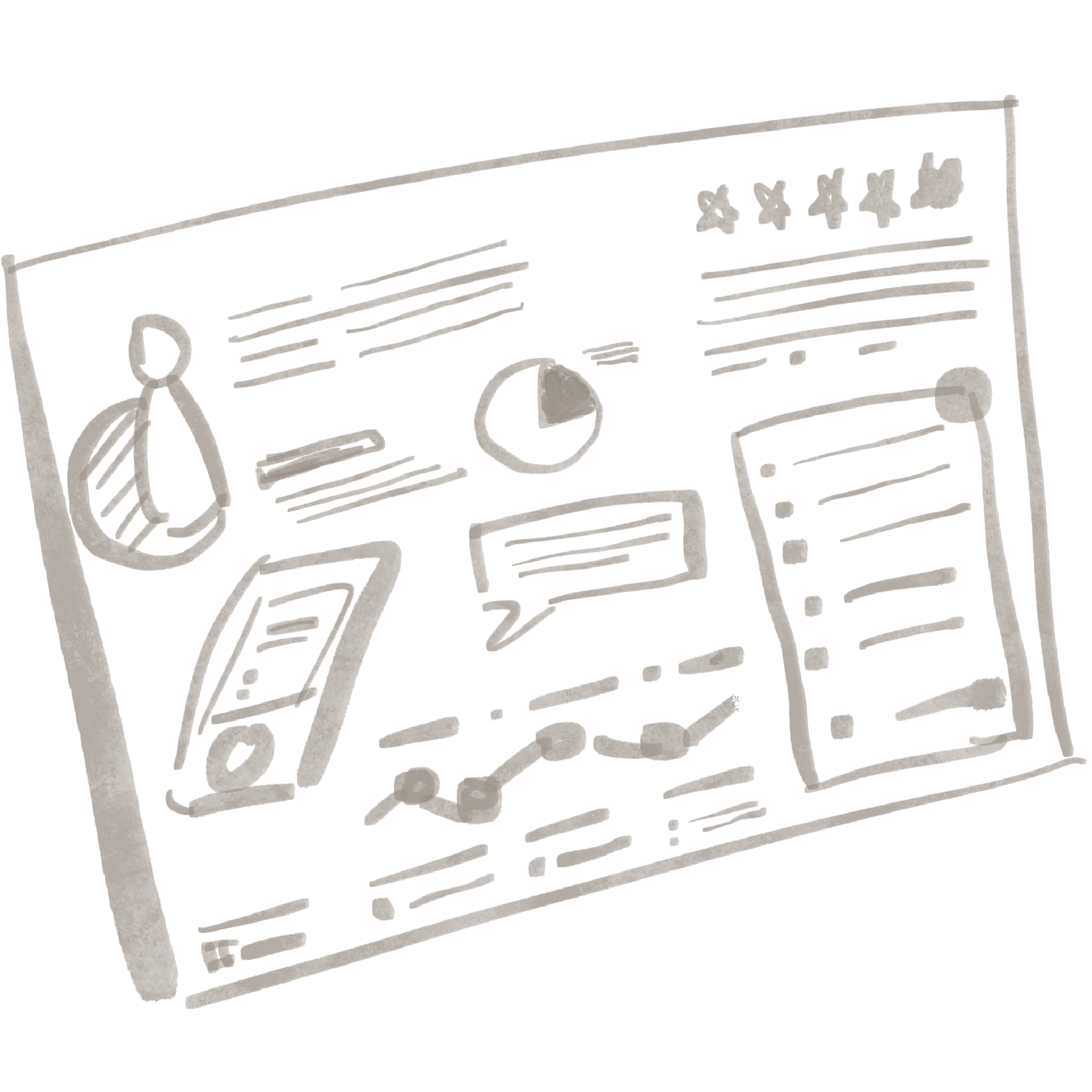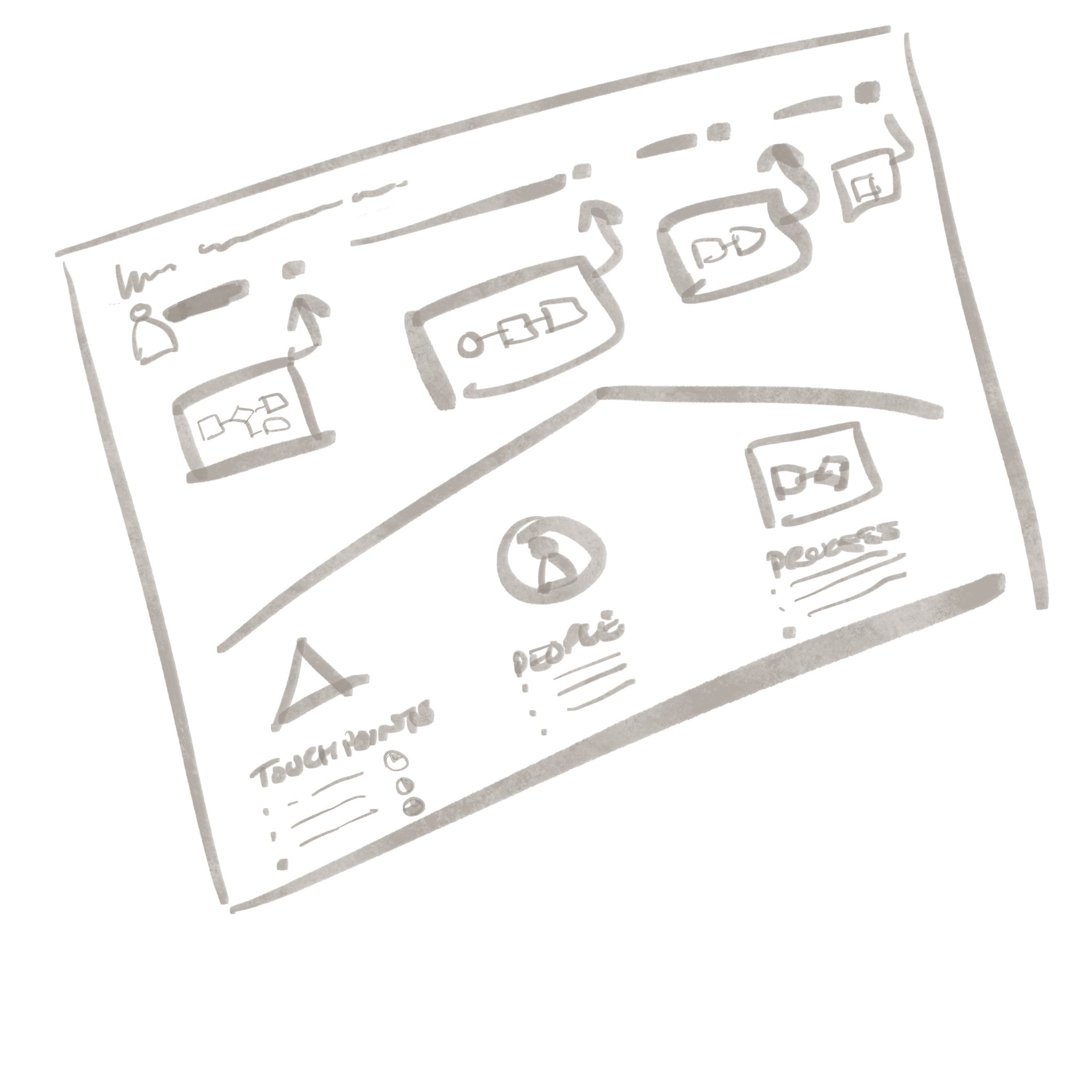Service design is a strategic game-changer.
Incorporating the following tools strategically can transform Service Design into a powerful driver of business strategy, enabling the creation of services and products that are customer-centric and aligned with the overall organisational vision and goals.
In this article, I will share a quick guide to the tools, their outcome and how they guide your strategy and will set you on your path to delivering customer-centric solutions that delight and get it right for your customers.
Service Blueprint
Service blueprints visually illustrate the end-to-end service experience, showcasing various touchpoints, interactions, processes, and underlying systems. They provide a structured representation of how different components come together to deliver the service or product.
What a Service Blueprint provides
Identify and define the different touchpoints a user interacts with during the service journey.
Maps out the steps or processes involved from the customer's perspective (frontstage) and the internal operations (backstage) that enable your product or service to be realised today or in the future state.
Showcase interactions between customers and touchpoints and interactions between various internal elements directly and indirectly through to the backstage elements.
They use visual elements like swim lanes, timelines, and annotations for clarity against agreed criteria.
It can clearly represent the current state and readily adapted to showcase the future state clearly.
Gained Outcome
End-to-end clear visualisation of how your customers connect with your product and services and how your organisation delivers on this by identifying the elements that make up the experience across people, process, technology and other enablers.
In the future state, it can go further to outline what the areas for improvement are, how they need to change and why doing so will create business and customer value.
Provides clarity of the people, process, touchpoints, technology and other enablers that support the delivery of your product or service. Which may extend to include external business partners when appropriate.
Makes it easier to define where to prioritise and focus your attention to be successful.
Improved communication and alignment among stakeholders, delivery partners and your team regarding how the service should function and how different parts of the organisation contribute to the service delivery of your product.
A tool that can lead to innovation, as they align on the priorities and enable ease in co-creation of ideas.
I have also used them to support the prioritisation and staging of Minimiam Viable, Products and Experiences.
How it will support your strategy
Guides Strategy: Service blueprints provide a strategic view of the service, aiding in identifying areas where the service aligns with the overall organisational strategy and where it can be optimised to meet strategic objectives.
Informs Strategy: Insights gained from the blueprint can inform strategic decisions by identifying critical touchpoints that require enhancement to align with the desired strategic direction.
Realises Strategy: By optimising the service based on the blueprint insights, organisations can effectively realise strategic goals related to improved customer experiences and operational efficiencies and align prioritisation to deliver outcomes.
Service Scenarios
Service scenarios are narratives that describe specific situations or use cases in which a user interacts with the service. They provide context, insights and data into how users may engage with the service in real-life scenarios.
What a Service Scenairo provides
Define the customer and user personas and their goals that can expand to outline and model customer behaviour and the value proposition, providing an understanding of what is important to them, highlighting the moments that matter and data to support recommendations.
Create storylines or narratives that depict how these personas interact with the service to accomplish certain tasks or goals to achieve their needs and/or goals.
Include details such as touchpoints used, emotions, and actions taken by the personas.
Gained Outcome
A deeper understanding of user behaviour and needs in various contexts, aiding in delivering services that cater to specific user scenarios, attract customers to your proposition and drive growth within your chosen markets.
Insights into potential pain points and opportunities to refine the service for an excellent experience that will create value for the business and customers.
How it will support your strategy
Guides Strategy: Service scenarios guide strategy by presenting potential user interaction scenarios, which can align with strategic goals and help design services that effectively address specific customer needs to attract and retain them.
Informs Strategy: Insights from service scenarios inform strategy by highlighting critical user touchpoints and interactions, assisting in strategic decision-making to enhance your product, services or touchpoints to drive customer satisfaction.
Realises Strategy: Service scenarios contribute to realising strategy by ensuring that the service design aligns with intended strategic outcomes, resulting in a more effective and customer-centric service.
Service Models
These are graphical or visual representations illustrating a service's structure, components, and relationships. They provide a conceptual framework for understanding the service's architecture and how different elements are connected.
What a Service Model provides
Defines the key service components, including touchpoints, processes, actors, and resources.
Illustrate the relationships and dependencies between these components, often using diagrams like flowcharts, network diagrams, or entity-relationship diagrams.
Gained outcome
Clear visualisation of the service's architecture, aiding in effective communication and comprehension among team members and stakeholders.
Identify potential bottlenecks, redundancies, or areas for optimisation within the service structure.
Ability to share a current or future state on a page easily.
How it supports your strategy
Guides Strategy: Service models guide strategy by presenting a visual framework of the service, facilitating strategic decisions on how the service aligns with organisational goals and how it can be optimised for better performance.
Informs Strategy: Insights gained from analysing service models inform strategy by identifying focus areas of the product or service and stakeholders to partner with to realise your organisation's strategic objectives.
Realises Strategy: Implementing improvements based on the service model can aid in realising strategy by aligning the service structure and operations with the intended strategic outcomes.
Service Concepts
These are innovative ways and conceptual ideas for a potential new service or product improvement. They showcase the core value proposition and the unique features of the target state outcome.
What a Service Concept provides
A collective understanding of what will be achieved by showcasing key concepts representing the “hero elements” that align with customer needs and business objectives.
They highlight and provide tangible descriptions of the Why, What and How it showcases the product or services, features, value, creates a connection with the target audience, and how it addresses their needs and creates value in their lives.
They connect the organisation and your team with the future state by use of visuals, storyboards, basic prototypes or what I like to use are videos to bring the concept to life. Apple does this for all their upcoming product launches.
Gained outcome
Exploration of innovative service or product ideas, providing a foundation for further development and refinement.
A tangible representation of the service or product's potential value and differentiation in the market.
A way to engage and gain support across the business is by clarifying the future state and connecting them with what success looks like.
How they support your strategy
Guides Strategy: Service concepts guide strategy by connecting with the future state by showcasing ideas that can bring an organisation's strategic direction to life, engaging around a product or service value, key features and hero moments that will delight customers and connect them with the value of the offering.
Inform Strategy: Insights from service concepts inform strategy by showcasing the potential impact of adopting certain concepts on the organisation's roadmap that shares the value that will be realised.
Realises Strategy: Developing and implementing service concepts can aid in realising strategy by providing innovative solutions that align with strategic goals and enhance the organisation's service and product portfolio.
Service Evaluations, Service Safari & Landscape Reviews
Whilst this can be classed differently, I have grouped them here for ease. They all involve assessing a service or a product’s performance, customer satisfaction and alignment with defined principles, objectives and requirements. With Service Safari & Landscape Reviews, they take it wider and assess against like services that can be within or externally from your organisation. These evaluations ensure that what we have in the market or potentially want to introduce meets the intended goals.
What a Service Evaluation provides
Uses predefined evaluation criteria, level of alignment, target performance and usability aspects, efficiency, effectiveness and overall customer satisfaction.
Provides both qualitative and quantitative data to base assessment.
Summary of the data and feedback to share the assessment outcome and recommend a course of action. This could be in the form of a SWOT analysis or a ranking system against the criteria.
Gained outcome
Actionable insights into how well the service or product meets customer needs and organisational goals.
They can also prove or assess a hypothesis, points of view or concepts with target customers.
Identifying areas for refinement to allow for iterative improvements and ultimately enhance the service or product's effectiveness against the agreed criteria.
Can define based on principles what to prioritise, focus on or even discontinue.
Can inform market and industry assessments.
How it will support your strategy
Guides Strategy: Service evaluations guide strategy by providing insights into how well the service or product aligns with the overall organisational strategy and goals.
Informs Strategy: Insights from service evaluations inform strategy by highlighting areas where the service or product may require modification or discontinuation to align with strategic objectives and enhance customer satisfaction.
Realises Strategy: Implementing improvements based on evaluation findings can aid in realising strategy by ensuring that the service or product meets the intended strategic outcomes and principles that result in alignment, improved performance and customer satisfaction.
By understanding how each element can guide, inform, and realise strategy, organisations can leverage them effectively to design and deliver services and products that align with broader strategic goals, enhance customer experiences, and drive business success.
It’s acknowledged that this is not an exhaustive list but a good start to help you create customer-centricity in aligning with your organisation's strategy and building out your delivery roadmap.
If you need help with bringing your strategy to life, and creating excellent services and products, I would be more than happy to assist you and your teams.
Check out my services here.
Check out my earlier blog on Mastering Vision to Action: The Roadmap.




